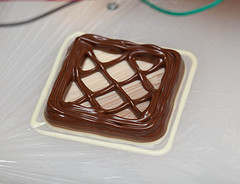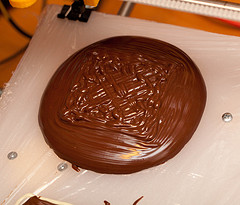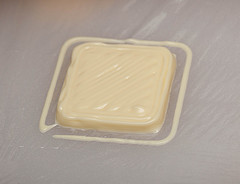Chocolate Extrusion
Chocolate is one material which has a paste-like consistency when molten and a limited ability to be extruded into a shape which it retains until solidifying, making it a candidate for building objects with a FDM-like process.
Behaviour and properties
Chocolate is actually a fairly complex material. It can crystallize into six different forms, each forming in different temperature range. Of these, the first four (counting from lowest to highest temperature) are undesirable: they are soft, crumbly and melt too easily. The sixth form takes weeks to months to form. The fifth form is sought after and the mark of a quality chocolate: having a pleasant mouth feel and breaking with a sharp snap. Processing the chocolate so that it predominantly takes the fifth form is called tempering.
The fifth crystal form melts at 33.8 °C. If the chocolate is heated above that temperature, it loses it's tempering and when cooled, crystallizes predominantly in the first four forms. It also loses the ability to retain any form in the molten state.
However, by melting the chocolate very carefully and avoiding exceeding the 33.8 °C, it's possible to retain the tempering even in the molten state. The chocolate will flow on it's own when poured as a larger mass, but when dribbled from a spoon, it won't disappear back into the molten mass immediately, but instead stay in the form it was dropped into for some time. This makes it possible to build actual objects from extruded chocolate.
Extruder
Chocolate can be extruded from a Moineau Extruder. In suitable temperatures, it will flow into the extruder without external pressure but also retain the form it was extruded into.


